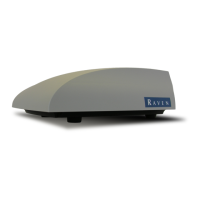Chapter1
l
Mount GNSS antennas with a clear, unobstructed view of the sky.
l
A minimum clearance of 1 m [39 in] is recommended around the GNSS antenna
to help avoid common issues with signal interference. Do not mount cellular,
radio, or other GNSS antennas within this area.
l
Mount the GNSS antenna to the tallest point of the machine. Avoid mounting the
antenna in a location where obstructions (e.g. bins/hoppers, cab roof lines, equip-
ment frame or structural elements, etc.) may rise into the antenna view.
Note: The antenna view typically starts 5° to 10° above horizontal from the base
of the antenna and extends over the skyward face of the receiver/antenna.
l
GNSS is a line-of-sight system. A clear path must exist between the satellite and the
GNSS antenna.
l
Obstructions such as buildings, tree branches and limbs, as well as components
of the vehicle such as a fiberglass or metal roof, and etc. may cause signal multi-
path or completely block the GNSS receiver.
l
Electrical and magnetic fields can interfere with GNSS or L-Band signals.
l
Avoid mounting GNSS receivers or antennas near components such as radio or
cellular antennas, electrical motors, generators, alternators, strobe lights, radio
transmitters, radio or cellular antennas, etc.
l
Over-head power lines, microwave dishes, radar, other active antennas, etc. can
interfere with GNSS signal.
l
Mount the Field Hub cellular and diversity antennas at least 1 m [39 in] apart. Avoid
mounting other cellular, radio, or GNSS aerials within this area.
Hose Routing
The word “hose” is used to describe any flexible, fluid carrying components. Use the
following guidelines and recommendations when connecting and routing hoses while
installing or maintaining this Raven system:
l
Leave protective caps/covers over hose ends until connecting the end into the
hydraulic system to help prevent contaminants from entering the system.
6

